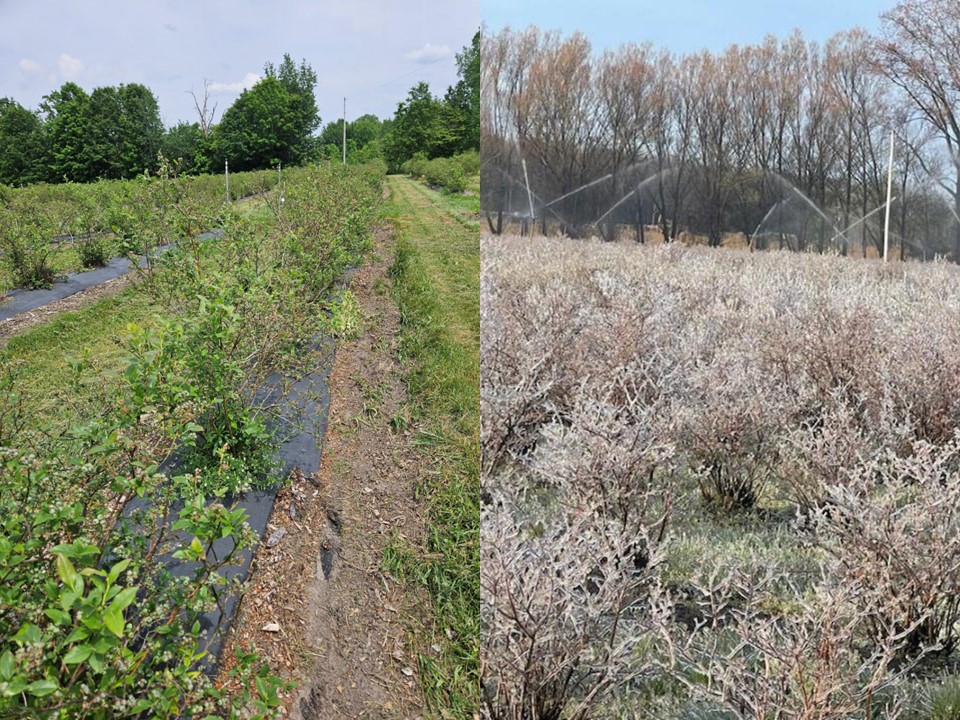West central Michigan small fruit update – June 5, 2024
Low temperatures and rainy conditions slowed down the early start of blueberry growth and development, but they reverted to a more typical tempered one.

Prevalent tempered conditions are characterized by maximum and minimum daily temperatures of 72 and 48 degrees Fahrenheit with an average growing degree-day (GDD) accumulation of 11 GDD (base 50 F). There has been rain, but accumulation has been minimum: 3 inches in April and 4 inches in May for Grand Junction, Michigan, and 2.5 inches in both April and May in west centra Michigan. This lack of substantial precipitation created a water deficit affecting blueberries and strawberries at a moment when hydric demand for bloom and fruit set is overly critical.
Regarding crop conditions, blueberries are in the green berry stage, strawberries are harvested and summer red raspberry fruit is coloring. Strawberries are having issues due to climate change and the presence of diseases and insects. In early April, flower thrips caused damage in early fields and growers had to apply insecticides to control them. In addition, daily climatic conditions during April and May fluctuated between freezing temperatures at night and hot temperatures above 50 F during day hours. Those low temperatures caused pollination problems resulting in small berries of low quality.
Another problem is plant and fruit diseases. Growers complained about black root rot and leather rot. Black root rot is one of the major problems in west central Michigan. According to tissue analysis and Michigan State University Extension plant pathologists, this disease is caused by a complex of root rot pathogens and nematodes. If you are observing symptoms as those described here, take plant samples and send them to Michigan State University (MSU) Plant & Pest Diagnostics for identification of the problem (Photo 1).
For blueberries, the situation is extraordinary. We had an excellent bloom period due to mild winter conditions. However, unseasonal warm temperatures during winter and early spring advanced plant growth and development for more than 15 days compared to the normal period. Depending on the location, budbreak and bloom of most blueberry varieties occurred 15 to 20 days earlier than normal. The early beginning of the budbreak and bloom of most blueberry varieties caught growers by surprise. Mid- and late season varieties were exposed to spring frost, and in most cases, growers were unprepared for frost management and control at that time.
Daily temperatures in April and May presented short but frequent periods of freezing temperatures at night and hot temperatures during day hours above 50-60 F. This combination of freezing temperatures at night and hot temperatures above 50 F during the day caused substantial damage to vegetative buds and green tissues already emerging from dormancy. Most affected varieties were Bluecrop, Jersey and Elliott. Damage appears as canes with fruit but no leaves. In addition, a spring drought weakened plants in affected field contributing to the lack of foliage in affected shoots. Fields well irrigated present freeze/frost damage but in a minor intensity (Photo 2).

Regarding insect problems in blueberries, cranberry fruitworm and cherry fruitworm are finishing the adult overwintering flight. They emerged earlier than normal. As of June 5, according to our phenology models, cherry fruitworm larvae have hatched and damaged fruit is already found. Cranberry fruitworm is still ovipositing but more than 50% of the oviposition has occurred. However, no hatched eggs or fruit damaged by cranberry fruitworm has been found.
For growers that missed the first insecticide application against cherry fruitworm, you could apply insecticides with curative effect like Imidan or Assail. Check the 2024 Michigan Fruit Management Guide (Bulletin E-154) for more insecticide options and doses.



 Print
Print Email
Email




